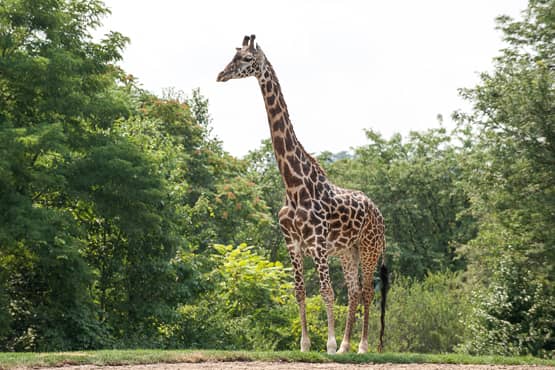Masai Giraffe
[Giraffa camelopardalis tippelskirchi]
Share:
Quick Facts
Size: Males can grow up to 18 feet and females can reach 14 feet in height
Range: Kenya, Tanzania
Habitat: African Savanna south of the Sahara Desert
Life span: 15-20 years
The Masai giraffe, also known as the Kilimanjaro giraffe, is the largest subspecies of giraffe and the tallest land mammal on earth.

Masai giraffes are indentified by the oak leaf pattern on their coat.
About Masai Giraffes
A giraffe may eat up to 75 pounds of food per day. Giraffes spend most of their day eating because they only get a few leaves in each bite. Their favorite leaves are acacia trees. Despite the fact that the acacia trees have long thorns, the giraffes use their 18-to-20-inch tongue to reach around the thorns. When giraffes are not eating, they chew their cud. Acacia leaves contain a lot of water, so giraffes can go long periods of time without having to get a drink of water. Giraffes are very vulnerable when they are drinking because they have to bend a long way down to drink. Giraffes can drink up to 10 gallons of water a day.
Gestation is 14 months. When a baby giraffe, called a calf, is born, he or she drops about six feet to the ground, head first. The fall does not hurt the baby. At birth, the calves are about six feet tall and weigh between 100 to 150 pounds. The calf can stand up and walk after about an hour. Giraffes reach maturity at about three to five years of age.
A giraffe’s feet are the size of a dinner plate- about 12 inches. Giraffes have the same number of vertebrae in their necks as humans. A giraffe’s tongue is 18 to 20 inches long and black in color. The black color helps to protect the tongue from getting sunburned as the giraffes eats. Giraffes can moo, hiss, roar, and whistle. Giraffes have the longest tail of any land animal. Their tails can be eight feet long. The running speed of a giraffe is 35 miles per hour.
Location in the Zoo: African Savanna
Schedule: Warm weather only
